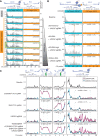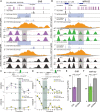A modular dCas9-SunTag DNMT3A epigenome editing system overcomes pervasive off-target activity of direct fusion dCas9-DNMT3A constructs
- PMID: 29907613
- PMCID: PMC6071642
- DOI: 10.1101/gr.233049.117
A modular dCas9-SunTag DNMT3A epigenome editing system overcomes pervasive off-target activity of direct fusion dCas9-DNMT3A constructs
Abstract
Detection of DNA methylation in the genome has been possible for decades; however, the ability to deliberately and specifically manipulate local DNA methylation states in the genome has been extremely limited. Consequently, this has impeded our understanding of the direct effect of DNA methylation on transcriptional regulation and transcription factor binding in the native chromatin context. Thus, highly specific targeted epigenome editing tools are needed to address this. Recent adaptations of genome editing technologies, including fusion of the DNMT3A DNA methyltransferase catalytic domain to catalytically inactive Cas9 (dC9-D3A), have aimed to alter DNA methylation at desired loci. Here, we show that these tools exhibit consistent off-target DNA methylation deposition in the genome, limiting their capabilities to unambiguously assess the functional consequences of DNA methylation. To address this, we developed a modular dCas9-SunTag (dC9Sun-D3A) system that can recruit multiple DNMT3A catalytic domains to a target site for editing DNA methylation. dC9Sun-D3A is tunable, specific, and exhibits much higher induction of DNA methylation at target sites than the dC9-D3A direct fusion protein. Importantly, genome-wide characterization of dC9Sun-D3A binding sites and DNA methylation revealed minimal off-target protein binding and induction of DNA methylation with dC9Sun-D3A, compared to pervasive off-target methylation by dC9-D3A. Furthermore, we used dC9Sun-D3A to demonstrate the binding sensitivity to DNA methylation for CTCF and NRF1 in situ. Overall, this modular dC9Sun-D3A system enables precise DNA methylation deposition with the lowest off-target DNA methylation levels reported to date, allowing accurate functional determination of the role of DNA methylation at single loci.
© 2018 Pflueger et al.; Published by Cold Spring Harbor Laboratory Press.
Figures





Similar articles
-
DNA epigenome editing using CRISPR-Cas SunTag-directed DNMT3A.Genome Biol. 2017 Sep 18;18(1):176. doi: 10.1186/s13059-017-1306-z. Genome Biol. 2017. PMID: 28923089 Free PMC article.
-
Epigenome editing strategies for the functional annotation of CTCF insulators.Nat Commun. 2019 Sep 18;10(1):4258. doi: 10.1038/s41467-019-12166-w. Nat Commun. 2019. PMID: 31534142 Free PMC article.
-
Genome-wide determination of on-target and off-target characteristics for RNA-guided DNA methylation by dCas9 methyltransferases.Gigascience. 2018 Mar 1;7(3):1-19. doi: 10.1093/gigascience/giy011. Gigascience. 2018. PMID: 29635374 Free PMC article.
-
A review on CRISPR/Cas-based epigenetic regulation in plants.Int J Biol Macromol. 2022 Oct 31;219:1261-1271. doi: 10.1016/j.ijbiomac.2022.08.182. Epub 2022 Aug 31. Int J Biol Macromol. 2022. PMID: 36057300 Review.
-
CRISPR/Cas9-based epigenome editing: An overview of dCas9-based tools with special emphasis on off-target activity.Methods. 2019 Jul 15;164-165:109-119. doi: 10.1016/j.ymeth.2019.05.003. Epub 2019 May 6. Methods. 2019. PMID: 31071448 Review.
Cited by
-
Targeted Manipulation of Histone Modification in Medaka Embryos.Methods Mol Biol. 2023;2577:279-293. doi: 10.1007/978-1-0716-2724-2_20. Methods Mol Biol. 2023. PMID: 36173581
-
RNA variant assessment using transactivation and transdifferentiation.Am J Hum Genet. 2024 Aug 8;111(8):1673-1699. doi: 10.1016/j.ajhg.2024.06.018. Epub 2024 Jul 30. Am J Hum Genet. 2024. PMID: 39084224 Free PMC article.
-
Targeted Modification of Epigenetic Marks Using CRISPR/dCas9-SunTag-Based Modular Epigenetic Toolkit.Methods Mol Biol. 2024;2761:81-91. doi: 10.1007/978-1-0716-3662-6_7. Methods Mol Biol. 2024. PMID: 38427231
-
Super-Enhancers, Phase-Separated Condensates, and 3D Genome Organization in Cancer.Cancers (Basel). 2022 Jun 10;14(12):2866. doi: 10.3390/cancers14122866. Cancers (Basel). 2022. PMID: 35740532 Free PMC article. Review.
-
Epigenome engineering: new technologies for precision medicine.Nucleic Acids Res. 2020 Dec 16;48(22):12453-12482. doi: 10.1093/nar/gkaa1000. Nucleic Acids Res. 2020. PMID: 33196851 Free PMC article.
References
-
- Bernstein BE, Meissner A, Lander ES. 2007. The mammalian epigenome. Cell 128: 669–681. - PubMed
Publication types
MeSH terms
Substances
Grants and funding
LinkOut - more resources
Full Text Sources
Other Literature Sources
Molecular Biology Databases
Research Materials
